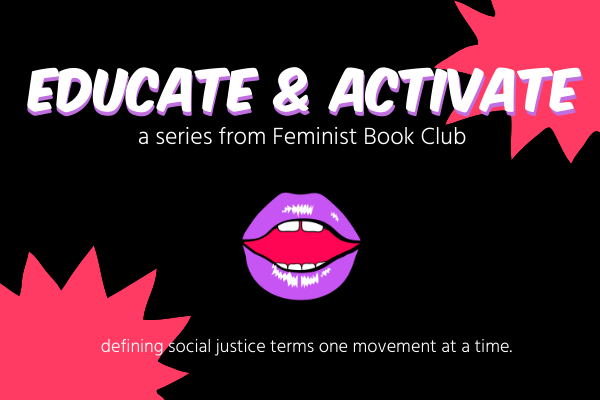Feminist Book Club blog contributors are working together to create posts as an “Educate & Activate” series. We will define a term or movement, provide historical context, and give you additional resources to learn more. We believe that an educated populace can be better activists, accomplices and co-conspirators. It is important to note that these are meant to be brief descriptions and not inclusive or exhaustive of all resources. We urge you to continue being curious, and continue learning more.
Definition
TERF stands for Trans-Exclusionary Radical Feminist and describes transphobic feminists. What this means is TERFs do not consider trans women to be ‘real women’ or trans men to be ‘real men’ or non-binary people to exist at all.

First Usage
The term TERF originated in the 1970s as part of feminist philosophy. During this time radical feminists thought there needed to be a separate word for feminists who supported trans women and those who did not. It was during this time feminist groups were creating separate spaces for both women and men to exist in, and some feminists debated whether transgender women should be included.

History
It’s believed that trans-inclusive cisgender feminist writer, Viv Smythe, is credited with coining the term TERF in a 2008 blog for The Guardian, but she simply popularized it, bringing attention to a radical form of feminism dating back to the 1970s rooted in sex essentialism. Smythe said the terms is “a shorthand to describe one cohort of feminists who self-identify as radical and are unwilling to recognize trans women as sisters, unlike those of us who do.“
There is some opposition to the term TERF as it continues to show up in mass media, sparking debates on whether the term is a slur and/or hate speech or a definitive term to differentiate anti-trans feminists. Some feminists described as TERFs dislike the term and would rather be called, “gender critical” as explained in Sarah Ditum’s 2017 article, “What is a TERF? How an Internet Buzzword Became a Mainstream Slur,” that discusses that the term can spark violence, and references a situation that occurred on September 17, 2017 on Speaker’s Corner where a group of women gathered in Hyde Park for an event called, “What is Gender: The Gender Recognition Act and Beyond.” The group was met by protestors who chanted “When TERFs attack, we fight back!” and one individual was physically attacked.
In 2019, Sophie Lewis discussed in The New York Times how in Britain the mainstream feminist movement had become anti-trans and the term TERF was beginning to be “a catchall for all anti-transgender feminists, regardless of whether they are radical.” She goes onto explain, “TERFs have effectively succeeded in framing the question of trans rights entirely around their own concerns: that is, how these rights for others could contribute to “female erasure.”
Most recently, author JK Rowling has been making headlines for her transphobic twitter rants and labeled a TERF. Below is her series of tweets from June 6, 2020:
@jk__rowling: “If sex isn’t real, there’s no same-sex attraction. If sex isn’t real, the lived reality of women globally is erased. I know and love trans people but erasing the concept of sex removes the ability of many to meaningfully discuss their lives. It isn’t hate to speak the truth.
The idea that women like me, who’ve been empathetic to trans people for decades, feeling kinship because they’re vulnerable in the same way as women – ie, to male violence – ‘hate’ trans people because they think sex is real and has lived consequences – is a nonsense.
I respect every trans person’s right to live any way that feels authentic and comfortable to them. I’d march with you if you were discriminated against on the basis of being trans. At the same time, my life has been shaped by being female. I do not believe it’s hateful to say so.”
Actors who have starred in the film adaptation of her book series, Harry Potter, have spoken out against Rowling. Most notably, Daniel Radcliffe wrote an essay for LGBTQ non-profit, The Trevor Project. Radcliffe wrote, “Transgender women are women. It’s clear that we need to do more to support transgender and nonbinary people, not invalidate their identities, and not cause further harm.”
GLAAD also tweeted in response to Rowling’s rants calling them “inaccurate and cruel,” and encouraged anyone frustrated with her opinion to donate to organizations that support the Black transgender community.
Others also replied to her tweets trying to clarify why her stance is wrong and hurtful:
“As a physician, I want people to know that sex exists on a bimodal biological spectrum just like gender exists on a bimodal sociological spectrum. While most identify as either female or male, there are intersex and trans individuals who identities are just as valid and real.”
“You’re a smart person. How do you not yet understand the difference between sex and gender? The only way I can possibly explain your ignorance at this point is willfulness. It’s incredibly disappointing.”
“We’re not saying sex isn’t real. We’re saying it’s different from gender. My assigned sex at birth was male. But I identify as a woman.”
In the end, TERF is not a slur, it’s being transphobic that is the problem.
In case it’s not clear, Feminist Book Club welcomes all genders.
Always has. Always will.
Resources:
-
- Vox: The rise of anti-trans “radical” feminists, explained
- USA Today: What’s a TERF and why is ‘Harry Potter’ author J.K. Rowling being called one?
- The Conversation: Why the words we use matter when describing anti-trans activists
- Human Rights Campaign: Understanding the Transgender Community



Pingback: EDUCATE & ACTIVATE: TERF Part II: Genital Checks and Transphobia Masked as Feminism